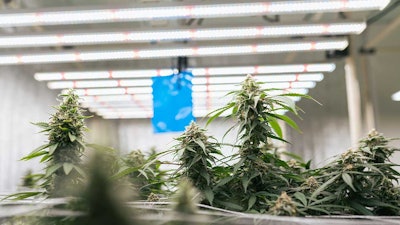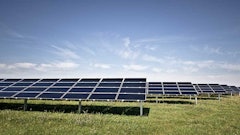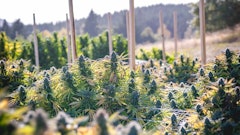
In today’s landscape, it’s incumbent upon cannabis businesses to understand their operation’s carbon emissions and resource use.
Consumers, and especially cannabis consumers, are increasingly mindful of the companies they do business with, and many want to ensure that their individual purchasing decisions are contributing to sustainable climate and resource efficiency practices. Beyond social movements, understanding resource use and facility efficiency can help operators identify cost-saving opportunities, which can potentially be maximized through utility incentives.
Sustainability initiatives can sound quixotic to cannabis operators. That’s why, over the years, Resource Innovation Institute (RII) has developed Best Practices Guides, policy reports, educational webinars and, most notably, our PowerScore energy and water benchmarking platform. All of these tools offer practical, results-centered information to educate operators on how they can make more sustainable and resource-efficient decisions.
While we have been working to illuminate this information and these tools for years, it’s never too late for operators to make sustainability a priority in their business development plans. With that in mind, here are the sustainability and resource efficiency goals RII and its partners are focusing on over the next two years, including practical ways cannabis growers can achieve these priorities while improving their bottom lines.
1. Benchmarking
The first priority RII has identified is data collection of sustainability metrics to improve benchmarking efficiency.
“It can be difficult for utilities to benchmark savings for cannabis operations,” says RII member, Cody Allen, national offerings owner for agriculture at ICF, a global consulting and technology services firm. “Cannabis is a federally illegal substance; there’s no backing from [federal agencies] where you can dive into actual tools and resources specific to that industry.”
While there is more data and information available about controlled environment agriculture (CEA) now, it’s still a relatively new research area for the United States Department of Agriculture (USDA) compared to traditional farming. This data gap means there are a lot of unknowns for cannabis operators, regulators, utilities and equipment manufacturers when it comes to developing best practices, standards and policies. Cannabis operators who enroll in RII’s PowerScore program can work to fill that gap.
By sharing environmental data and systems information with RII through PowerScore, cannabis cultivators help build a robust dataset. This shows state and federal government agencies and utilities how the cannabis industry is becoming more efficient and where it needs additional resources, such as technical assistance and incentives, to continue its sustainability journey. For example, when the cannabis industry becomes federally regulated, the Department of Energy (DOE) could develop technical reference manuals (TRMs) from that aggregated data, or the USDA could offer subsidies to upgrade environmental control systems to higher efficiency units.
Cannabis growers won’t be able to tap into federal funds (yet). However, state and local grants and incentives are available to the cannabis industry. RII’s PowerScore is also one of the few USDA-supported tools that cannabis operators can leverage, allowing the cannabis sector to learn from other crop producers.
In addition, RII has recently partnered with CEA design-build general contractor ARCO/Murray to develop the first CEA Credentialing Curriculum, another USDA-supported initiative, to answer the need for highly qualified CEA design and construction professionals.
Resource efficiency isn’t just about meeting a regulatory requirement—it directly impacts your operation’s bottom line and your market valuation. Benchmarking your metrics to identify where your cannabis facility can improve is the first step in accessing these benefits and, potentially, incentives and other support offered through state and utility energy efficiency programs.
2. Climate-Smart Approach to Resource Use
There have been initiatives during the past two decades by federal authorities and the energy sector to electrify and decarbonize energy sources to meet climate change mitigation goals.
“There is a clear consensus based on years of climate studies and modeling that our best path forward, both in terms of meeting carbon reduction goals and doing it in a way that would be least disruptive to the economy, is to electrify everything,” says RII member Jennifer Amann, senior fellow at the American Council for an Energy-Efficient Economy (ACEEE), a nonprofit research organization.
We’ve seen several state and federal initiatives—including the recently passed Inflation Reduction Act—offer incentives to both businesses and households to move toward electrified systems. Utilities have also been generating more energy from clean sources and moving away from the use of fossil fuels as much as feasible. The goal, ultimately, is to create a climate-smart system with a clean demand and a clean supply that balance each other out.
Again, there are state, local and utility incentive programs available to cannabis cultivators willing to reduce and decarbonize their resource usage, either by adopting LED lighting fixtures, shifting to super-efficient geothermal heat pumps or leveraging combined heat and power (CHP) microgrids, either for your business alone or as part of a local collective with neighbors.
Utility demand-response programs also incentivize cannabis cultivators to shift their energy-intensive activities to off-peak periods when electricity demand is lower. Cannabis cultivators can implement technologies and practices like dimming lights to simulate sunrises and sunsets, staggering start times for energy-intensive systems or leveraging a CHP unit to reduce the demand on the grid during peak hours in their operations. “Utilities [in California] have to procure all cost-effective energy-efficiency before they look to other supply-side resources,” Amann says. Cultivators who can improve their energy efficiency help the utilities achieve their regulatory obligations, and the utility companies will compensate them for these services.
Beyond electrification and decarbonization, water use is another priority when developing a climate-smart economy. “One of the biggest opportunities for resource and sustainability efforts in cannabis operations is for cultivators to look into their water source and water conservation practices,” Allen says. adding that agriculture accounted for nearly half (42%) of total freshwater withdrawals in the U.S. in 2015, and about 70% of the world’s freshwater withdrawals go toward irrigation. “There’s a lot of pressure on the agriculture and cannabis industries when it comes to water conservation.”
3. Training and Credentialing
In cannabis and more broadly in CEA, there are education gaps that need to be bridged at the workforce level for companies pursuing sustainability goals. Teams need to understand not just how to grow plants in controlled environments, but how to do so in an efficient manner that minimizes waste and maximizes the operation’s return on investment (ROI).
As cannabis markets mature, wholesale prices typically compress, forcing cultivators to figure out a more sustainable cost structure and improve consistency across crops and facilities. For example, water circularity systems have shown how CEA operations can drastically cut down on their water use by reducing, remediating and recycling facility discharge water, ultimately reducing operational costs.
But to do it right and get the water-use savings and incentives, there has to be technical competence—and that will only come through a vetted curriculum that ensures the workforce is trained to support the operation with the best energy and water optimization practices. Many academic, government and nonprofit organizations are pooling efforts to provide this much-needed education and credentialing, including RII. We’ve seen the benefits of such education supporting the wide-scale adoption of LED lighting in horticultural environments—an area that has had an outsized positive impact on cannabis producer productivity and efficiency.
Cannabis cultivators can continue seeking out the latest peer-reviewed and data-backed information from vetted sources, working to implement these solutions in their operations and adding best practices to their standard operating procedures. Doing so will lead to a more sustainable economy and electrical grid, as well as a more sustainable and profitable business.
Derek Smith is the Executive Director of Resource Innovation Institute (RII), a nonprofit whose mission is to promote and quantify energy and water conservation in the cannabis industry. He has been a leader in triple bottom line ventures in the public, private and nonprofit sectors for more than 15 years. He founded and led Clean Energy Works, a nationally recognized nonprofit organization that facilitates residential energy efficiency upgrades throughout Oregon and Washington. He has directed energy programs for the City of Portland Bureau of Planning and Sustainability and also created an award-winning sustainability program for a national retailer.



















